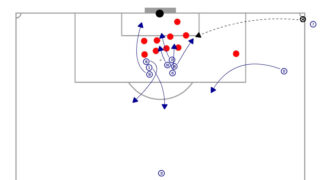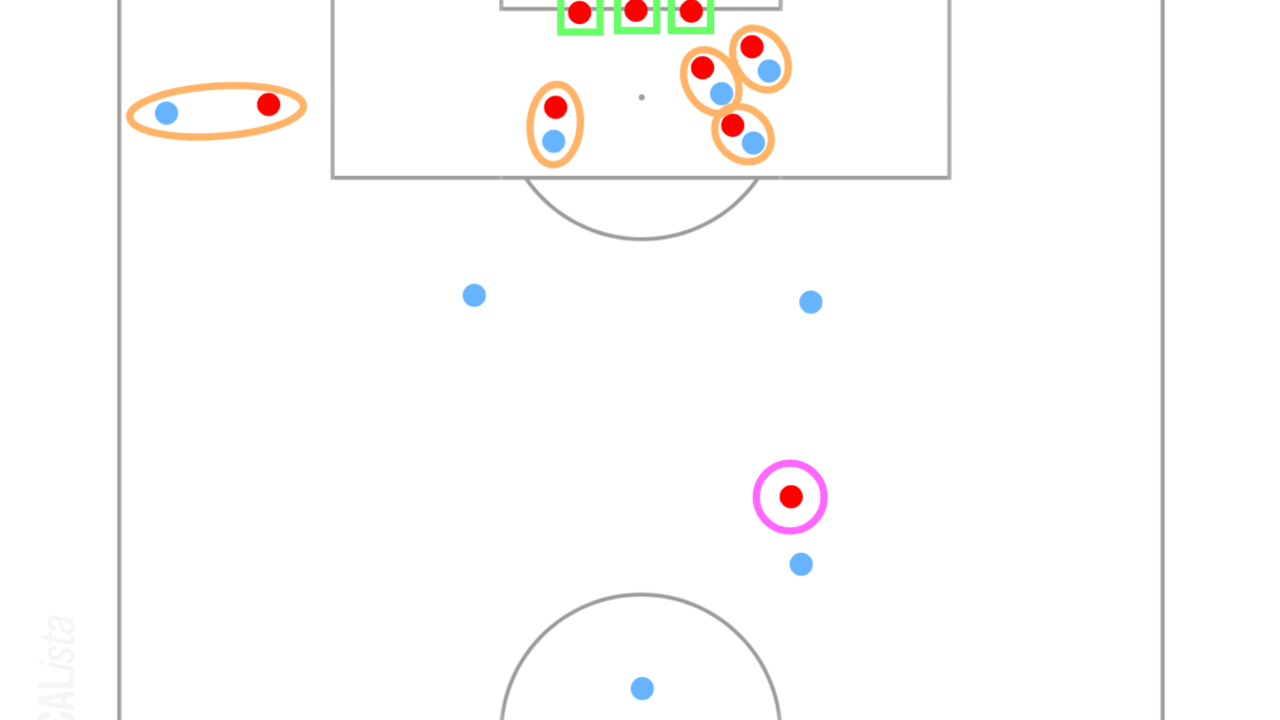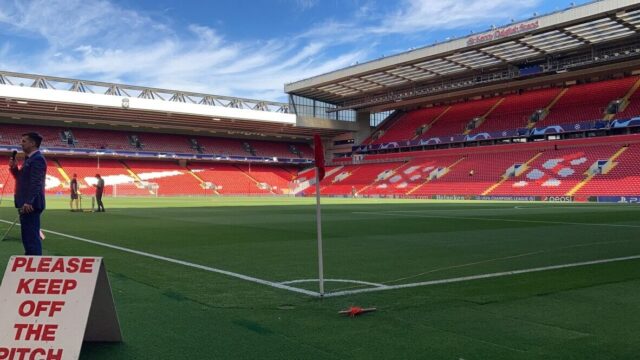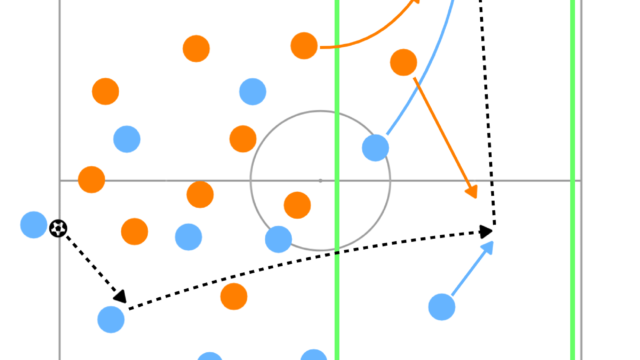Introduction
As goals from set pieces are vital in a game, it is obviously important to focus on not only attacking tactics but also defending tactics. However, in general, how to score goals from some trick plays is often discussed and defending strategies are largely ignored. They are always just categorised into man marking, zonal marking or mix. Then, what is the difference of these three strategies? In this article, the detail tactics of defending corner kicks are going to be analysed.

Difference & Similarity between Man Marking & Zonal Marking
Firstly, what is the difference between man marking, zonal marking and mix? When you are looking at the illustration below, even if the setup can be described as man marking, there are some players defending not opponents but space.

Then, how about this setup?

Is this zonal marking or still man marking? The number of defenders occupying space increases while all attackers in the box is marked by defenders. If this is mix setup, what is the difference between the previous setup and this? All attackers in the box are marked, why not it is still man marking? Then, how many players defending space is it required to be categorised as mix? Yes, the definition of them is really vague, so it is difficult to categorise them in a way which everyone can agree with.
Therefore, it is not the best way to use these three words, man marking, zonal marking and mix, to describe defensive setups for corner kicks because some people think the second setup as man marking and others think it is a mix defending.
However, everyone can agree with how each player is defending. For example, in the second illustration, four players are defending the space and others are marking the opposition players.

Therefore, it is a better way to describe the setup based on the number of players defending the space or opposition players. For example, in the example above, it is possible to explain the setup as ‘4+6 setup’. Additionally, if one or two defenders stay high for counterattacks, it can be 4+5+1 setup.

Moreover, not all defenders in the box are ready for clearing crosses. Usually, a player positions in inside of the edge of the box to prevent the opposition team from playing short from the corner.

This player often marks the opposition player who is positioned himself or herself at the edge of the box to offer a short passing lane. However, he or she often keeps the opposition player at a distance, so the defender looks like defending space. If nobody in the attacking team is at the edge of the box to receive the ball while the defender is still positioned himself or herself there, the defender is defending space. On the other hand, if the defender is adjusting his or her position with looking the opposition player, the player is marking the player. Overall, it is difficult to distinguish the marking type of the defender, but at least the defender is not defending crosses in front of the goal. However, this player is important because he or she can play a key role in transition between defending corner kicks and counterattacks. This will be analysed in a later chapter.
Overall, it is difficult to describe team’s setups into man marking, zonal marking or mix unless all players defend the space. However, what players are defending is obvious and it is possible to categorise them based on the number of players defending space or opposition players or staying high for counterattacks.
The Logic of Strategy
In the previous chapter, differences and similarities between man marking and zonal marking strategy as a team was discussed. Especially, the number of players defending space around six-yard box is controversial when mentioning the type of setups. Therefore, in this chapter, the rationale of number of players defending space or opposition attackers is mainly going to be analysed.
In general scenario when nobody is sent off or injured, there are 11 players on the pitch for each team. However, in terms of the number of available outfield players, the attacking player who takes a corner kick can only play it to someone else and is not allowed to dribble and step in, so there are nine outfield players for the attacking team can receive the ball while 10 outfield defenders can try to intercept the delivery. Consequently, there is always an overloaded situation for the defending team. In many cases, no matter whether defending based on man marking or zonal marking, mainly two defenders are positioned themselves in front of the goal with defending space. Then, the numerical advantage is given to the attacking team with 9v8. However, the attacking team often keeps having a spare player around the halfway line against the opposition attackers staying high to be ready for counterattacks. Even if there are no players of the defending team around the halfway line, a player of the attacking team stays there to prevent counterattacks. After these hidden logics, both teams can use same number of players in and around the box. Therefore, it is possible to say that the rationale of how to organise the defensive shape is how many opposition attackers defenders mark or leave in the numerically equal area.

However, there are some exceptions. firstly, if two attackers stand by a corner flag to play a short corner, the defending team sometimes places two defenders near the corner to make it numerically equal to prevent it before the ball is played. In this case, there will be an overloaded situation for the attacking team in the box. Additionally, the attacking team sometimes position all outfield players in or around the box and the goalkeeper steps up to the halfway line. If all defenders come back in the box, there is no threats to play counterattacks. Thus, it makes sense to let the goalkeeper stay around the centre circle to secure the ball cleared strongly by a defender. From defensive perspective, there is no obligation to use two defenders to defend space in front of the goal. If only a player defending space at the near post and a few players staying up front, it is possible to create numerically equal situation around the halfway line to play better counterattacks while keep marking all opposition attackers in the box. Overall, the hidden logics cannot be applied to all teams, but it is worth mentioning them because many teams follow them and it makes us easier to analyse the purpose of the opposition defensive setup by finding exceptions and assuming the reason behind them.
In next two chapters, the characteristics of man marking and zonal marking are going to be analysed.
Man Marking
In this chapter, the characteristic of defending corner kicks with man marking as a team and individual.
Firstly, as a team, the biggest strength of marking all opposition players is that it is theoretically possible to prevent them from heading the ball freely. All attackers are completely marked, so even if one of them can take a shot by a header, the defender marking him/her will make it difficult by making physical contact. Additionally, it is also possible to prevent them from creating mismatches. By analysing the opposition corner kicks, who to mark can be prepared. Therefore, it is possible to let the strongest defender mark the most dangerous opposition target player.
However, even though each player can focus on marking each allocated opponent, it is a difficult task for defenders to keep watching the ball and the marker. Better defenders can manage this job by keeping touching the opposition attacker to avoid being dismarked, but it is still hard to clear the ball well while marking him/her. Moreover, as tactics to interrupt defenders have been developed such as blocking or separate movements, just keeping marking opposition attackers is not an easy task, although it is clear for everyone to understand the task and also easy to blame the defender when conceding a goal.
To overcome the attacking tactics to beat man marking setups, defenders can develop the tactics of marking attackers. For example, switching each marker is one of the solutions against a blocking tactic. Creating 2v2 in the box and one of the attackers blocking the marker of the main target attacker to let him/her head the ball with space and time are the basic idea to lose markers. Against this tactic, it is possible for defenders to switch each attacker to mark to keep the opposition main target attacker under marking. However, this can cause a mismatch after swapping each marker.

Additionally, against separate movements, which some of attackers run towards each destination at the same time to confuse defenders, keeping the distance between defenders and attackers is a great option. This can help defenders to find each marker after attackers were split without being confused by separate movements.

Another solution to make it easier for defenders to mark attackers is reducing the load of the task for them. In general, defenders need to focus on keeping an eye on the ball and opponent and clearing the ball well. However, by placing some defenders around the six-yard box to defend the space and giving them the task of clearing the ball, the defenders marking the opposition attackers can only concentrate on marking them and disturbing their movements. Thanks to this, the defenders marking the attackers can focus on only marking them and avoid being lost by the opponent’s movement while watching the ball. Additionally, this can help especially small players. Not all players are big and strong enough to win aerial duels. However, in corner kicks, most of all players need to come back in the box to defend them. Therefore, it is important to help those players do their best.

In terms of weaknesses, man marking is a passive tactic. Each player needs to follow the opposition movements wherever they go. Thus, the main weakness is being exploited the space where the opposition team intentionally creates. Especially when most of all defenders mark the opposition attackers, there are few defenders in front of the goal to defend the space and this area can be targeted at.

Additionally, as the defending team needs to follow the opposition strategy, the number of defenders in the box, around the box or the halfway line depends on how many attackers the opposition team put in the box. Consequently, the number of players staying up front for counterattacks varies in every single game. Additionally, as defenders need to follow the opponent’s movements, where they go after the ball is delivered is also different. Thus, it is hard to practice a pattern of counterattacks after securing the second balls or the goalkeeper catching the ball if most of all defenders mark the opposition defenders.
In terms of analysis, managers or coaches need to check matchups after all substitutions. Recently, the number of players a team can substitute increased from three to five and the task for analysts or coaches became harder.
Overall, man marking is a clear strategy but passive and difficult. Thus, how to use extra defenders who defend the space can be critical and this will be discussed in the next chapter.
Zonal Marking
As it was mentioned earlier, even if all attackers are marked by defenders, there are often at least two extra defenders in the box. In many cases, these players can defend the space, but where they defend is different in each team. However, most of all team have at least a defender at the near post. Firstly, the reason behind this will be explained.
There are mainly two reasons of this. Firstly, it is an extremely dangerous pattern that an attacker flicks the ball at the first post. The goalkeeper cannot react if the ball is flicked in the close range to him/her. Even if the shot is not on target, if the ball is going towards the back post, one of the attackers can tap it in. Thus, clearing the ball at the near post is important. Additionally, if the opposition attacker starts to move towards the near post, the defender who marks him/her will follow the opponent behind him/her. In this case, if the ball is delivered to him/her at the first post, the attacker can reach it before the defender. Therefore, there needs to be someone at the near post who can intercept the delivery in front of the attacker. In case when the attacker is moving towards the back post, the defender will be inside of him/her. Thus, the defender can clear the ball in front of the attacker and there does not need to be an extra defender at the far post.

However, some teams have an extra defender at the back post. The main reason is to protect the shots towards the back post because the defender cannot contribute to clear the ball as it was mentioned before. Thus, the approach is based on how to protect the goal and not how to prevent from taking a shot. Consequently, the defending team will be forced to defend the balls delivered from corners with a man down. Thus, it is ineffective to have a defender at the back post.
Overall, in terms of extra defenders, many teams must have a defender at the near post and another defender will be often positioned himself/herself at the near post or in the middle of the six-yard box except for the back post area.
In general, the biggest difference between man marking and zonal marking is the number of things to be considered by defenders. With man marking, defenders need to focus on the opposition marker and the ball. However, with zonal marking, they can only concentrate on clearing the ball. They can stand still and wait for the ball delivered. Therefore, it becomes easier for defenders to clear the ball far from the goal with zonal marking.
However, as they are just standing still when the ball is delivered, if attackers sprint and attack the ball, defenders are physically weaker than attackers. Thus, they have a disadvantage in aerial duels if the defender needs to jump to clear the ball from just standing still.
Additionally, blind sides can be weaknesses of zonal marking. If an attacker appears from a defender’s blind side, the attacker can head the ball in front of the defender. Moreover, if most of all defenders defending the space, the far side will be the blind side. Thus, against zonal setups, it is a common tactic to deliver the ball to the far side and head it back in front of the goal. This is difficult for defenders to deal with the ball towards the far area because the farthest defender needs to turn the body angle or stepping back while watching the ball, which waste a few seconds.

Another area of weaknesses is the space around the D especially when many defenders cover the space in front of the six-yard box. To defend the space in front of the goal, some teams have everyone come back in the box. In this case, there will be no players around the D and volleys from straight balls from corners in that area are the possible attacking tactic.

In relation to this, securing the ball cleared by a defender is also a problem. As there are a few players around the edge of the box, it is more difficult to regain the second balls. Thus, it is important for the defending team to push the line up quickly to close down the space around the D.
In terms of the transition after corner kicks, zonal setups are better to consider counterattacks. This is because the defenders defending the space are in the same positions every time, so it is possible to practice a pattern to play counterattacks. Please find the detail about transition from set pieces in the article below.

Overall, it is possible to conclude that zonal marking is more active way to defend corner kicks because it is focusing on how well clear the ball instead of trying to force the mistakes of the opposition players.
It depends on managers’ philosophy how to organise the defensive setup against opposition corner kicks. However, it is worth knowing the advantages and disadvantages of each type of marking. If this article can help you little bit, I am glad about that. Thanks for reading.



